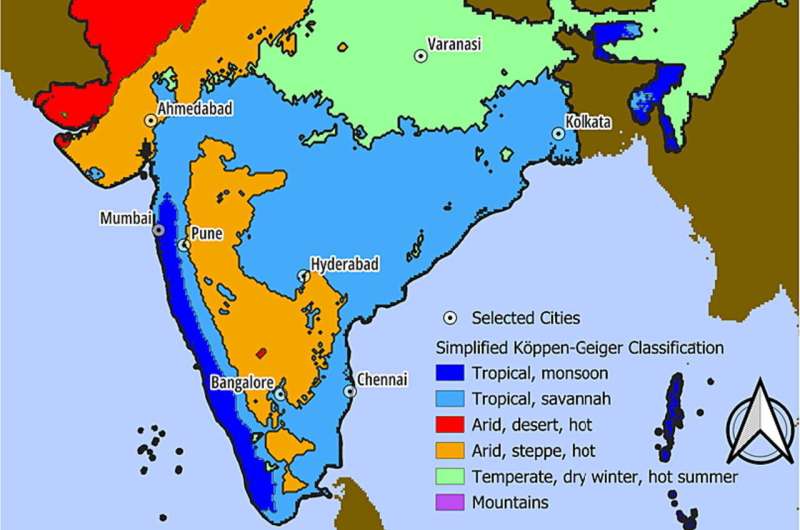This article has been reviewed according to Science X's editorial process and policies. Editors have highlighted the following attributes while ensuring the content's credibility:
fact-checked
peer-reviewed publication
trusted source
proofread
Researchers map mortality due to heat waves

While the most extreme heat waves have the greatest short-term impact on mortality, it is the mildest heat waves that kill most lives over time. This is because mild heat waves are more common. This is according to a new study published in Environment International that has mapped the health risks of heat waves in India.
There is no international consensus on what constitutes a heat wave. Different definitions are used in different countries based on different conditions. In Sweden, for example, SMHI classifies a heat wave as "a continuous period when the maximum daily temperature exceeds 25°C for at least five consecutive days," while a heat wave in India means that the temperature exceeds 40°C in low-lying terrain, or 30°C in mountainous regions.
As heat waves are projected to become more common as the Earth's climate warms, the health risks of temporarily elevated temperatures must be investigated further. So says an international consortium of researchers from Sweden, the US, Italy, the UK, Israel, and India. In a new study, they have therefore studied the effects of heat waves in India.
"We wanted to find out how much the risk of death increases during heat waves," says Jeroen de Bont, a researcher at the Institute of Environmental Medicine at Karolinska Institutet and first author of the study.
By examining excess mortality in ten cities in different parts of India with different climate zones between 2008 and 2019, the researchers were able to show how mortality varies, both with temperature and also with different definitions of what constitutes a heat wave.
By selecting the days that were hotter than 95, 97 or 99 percent of all days in the different regions, the researchers were able to create different definitions of heat waves and examine the health risks associated with them.
Unsurprisingly, the hottest and longest heat waves, those that were hotter than 99 percent of days and lasted at least five days, increased mortality the most—by over 33 percent. Heat waves that were hotter than 95 percent of all days and lasted only one day increased mortality the least—by just over 10 percent.
What is perhaps more surprising is that the mildest heat waves were the deadliest and that the number of deaths was more or less inversely proportional to the intensity and duration of the heat waves.
"This is because the milder heat waves were so much more common than the hotter ones. In the end, the most extreme heat waves turned out to cause the lowest number of deaths because they were so infrequent. One consequence of this may be that heat warnings may need to be triggered at lower temperature thresholds to protect more people," says Jeroen de Bont.
The researchers now argue that policymakers and other stakeholders need to understand and plan for both the relatively mild, short, and common, and the extreme, long, and uncommon heat waves in order to offer relevant measures to protect public health in the future.
More information: Jeroen de Bont et al, Impact of heatwaves on all-cause mortality in India: a comprehensive multi-city study, Environment International (2024). DOI: 10.1016/j.envint.2024.108461




















